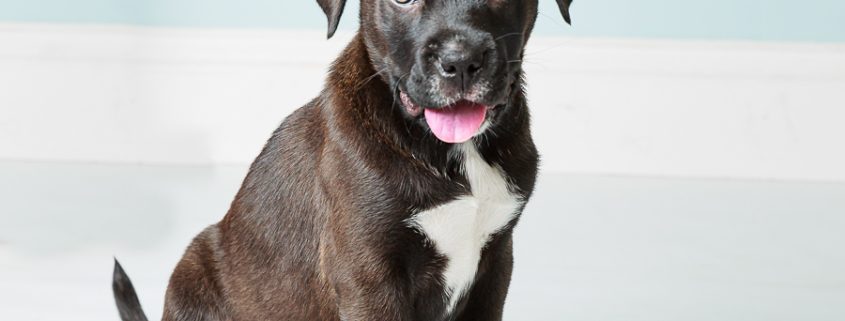Ask Crystal: Puppy Crate Training
Welcome to “Ask Crystal,” where you can ask your pet behavior questions! You can submit your question for Crystal at the bottom of the page!
Dear Crystal,
I recently adopted an 8-month old puppy from the shelter. We have had her for about a month and we are having a lot of issues with housetraining her. We were told that we should use a crate to help housetrain her, but she goes to the bathroom in the crate and just lies in it. I am not sure what to do. Help!
Sincerely,
Potty Problems
Dear Potty,
 In most cases, crates can be very helpful for house training a dog. It is natural for most dogs to not want to lie in their own waste, so the crate helps train their body to hold their waste. It helps build the muscles that allow them to hold off going to the bathroom for longer and longer. There are multiple reasons why a dog may be having accidents in their crate. If the dog is just having occasional accidents in its crate that may not be cause for alarm. If it is an everyday occurrence, then you have a more difficult situation on your hands.
In most cases, crates can be very helpful for house training a dog. It is natural for most dogs to not want to lie in their own waste, so the crate helps train their body to hold their waste. It helps build the muscles that allow them to hold off going to the bathroom for longer and longer. There are multiple reasons why a dog may be having accidents in their crate. If the dog is just having occasional accidents in its crate that may not be cause for alarm. If it is an everyday occurrence, then you have a more difficult situation on your hands.
The first step is to rule out any medical conditions. Intestinal parasites can cause diarrhea and soft stools which may cause a dog to have accidents. Urinary tract infections can cause a dog to urinate more frequently which may cause accidents as well. A visit to the vet is the first order of business.
Nutrition would be the next factor to look at here. How often does your dog defecate? If they are going 4 times a day, you may be feeding too much food. The recommendations on the back of food bags are often inflated. I have personally found that if I feed the recommended amounts, my dogs get chunky. Also, are you feeding a food with a lot of fillers which will cause the dog to need to defecate more? You may want to chat with your vet about what you are currently feeding and see if you could feed something which would produce less waste. Once you have evaluated her nutrition, you can start to look at the behavioral reasons why this behavior may be occurring.
There are a few different reasons why a dog may be having accidents in their crate. Be sure that you are giving adequate time for the dog to be outside to have an opportunity to potty. What situation did your dog come from? Dogs that were from puppy mills, pet stores or just kept in their crate for longer than they are physically able to hold it often get used to lying in their own excrement. Dogs that were kept outside have no concept of where they should be going to the bathroom and likely have no bladder control built up. Does your dog seem distressed when you come home or when you leave? A dog that is very stressed or distressed in a crate or when being left alone can have accidents in their crate. Dogs that are very stressed will often pant, shake, drool, pace and have stress vocalizations.
 Be sure that you are providing ample opportunities for the dog to go outside before you leave them alone. The first step is getting some occurrences of the dog pottying outside. You need to go outside with the dog so that you can see if they are going to the bathroom and be sure to reward heavily when they go. Walk around in the potty area and try to make it as boring as possible, no play until the dog has gone to the bathroom. When you can see they are starting to go, say your cue “go potty” and give a really amazing treat when they finish. Be sure to walk around or play afterwards for a couple minutes so the dog doesn’t think that going potty means they immediately have to go inside. If the dog is not going to the bathroom on leash, they may not be used to going potty while on a leash. Or they may have been punished for going in front of the previous owner, so they want to get some distance from you. Some dogs are too nervous or fearful to potty outside, especially when you first bring them home and they don’t feel safe yet. In that case, I suggest a light long line so that the dog can get some distance from you and not feel like they are on a leash. When you are home, be sure you are watching the dog like a hawk for any signs that she needs to go potty. That means the dog should never be out of sight of an adult. You can use baby gates, crates or leashes to confine the dog to the room with you. The more we can prevent accidents the further along we will get with our training.
Be sure that you are providing ample opportunities for the dog to go outside before you leave them alone. The first step is getting some occurrences of the dog pottying outside. You need to go outside with the dog so that you can see if they are going to the bathroom and be sure to reward heavily when they go. Walk around in the potty area and try to make it as boring as possible, no play until the dog has gone to the bathroom. When you can see they are starting to go, say your cue “go potty” and give a really amazing treat when they finish. Be sure to walk around or play afterwards for a couple minutes so the dog doesn’t think that going potty means they immediately have to go inside. If the dog is not going to the bathroom on leash, they may not be used to going potty while on a leash. Or they may have been punished for going in front of the previous owner, so they want to get some distance from you. Some dogs are too nervous or fearful to potty outside, especially when you first bring them home and they don’t feel safe yet. In that case, I suggest a light long line so that the dog can get some distance from you and not feel like they are on a leash. When you are home, be sure you are watching the dog like a hawk for any signs that she needs to go potty. That means the dog should never be out of sight of an adult. You can use baby gates, crates or leashes to confine the dog to the room with you. The more we can prevent accidents the further along we will get with our training.
Let’s talk about your setup for times when the dog needs to be alone. If your dog doesn’t mind being dirty, you may need to change the typical setup. The point is to give the dog an alternative place to go potty during this initial stage. In this way, we can try to encourage the dog to potty in a different area than the crate so we can start with encouraging the dog to not potty where they are sleeping. A couple options are setting up a puppy pen at the door of the open crate. You can put papers or puppy pads on the ground. Another option is to set up a baby pool or the bottom of any airline crate in the pen so the dog can potty in something more like the outside. You may want to avoid any soft bedding in the crate at this point, as it is absorbent and will soak up any urine so that the dog doesn’t feel the wetness. Don’t line the crate with newspapers or puppy pads as this may encourage the dog to potty in the crate.
If the dog seems to be stressed in a crate, we need to work out what the stress is related to. There are a lot of possibilities that can cause a dog to be upset about being in a crate. The most common reason is usually that the adopters did not take the proper time and training to acclimate the dog to being left in a crate. Dogs do not naturally like being in a crate, it takes time and a lot of treats and food to change their opinion about it. There are a lot of great articles and videos on proper crate training on the internet if you think that is the issue. Some dogs don’t want to be confined in any way whether a crate or a room. If that is the case, you may try a baby gate or a puppy proof room. Sometimes that helps the room to feel more open. Some dogs do really well in a doggy daycare or having a dog walker come over during the day if you need to leave the dog loose. That is obviously not ideal for housetraining purposes, but we can’t crate a dog that is hurting itself to get out. Some dogs have separation distress about being left alone from their people. If you think that might be the case, I highly recommend a certified behaviorist to do a consultation with you.
Housetraining a dog that doesn’t mind being dirty takes a lot of patience and some creativity. Keep in mind that the dog has been allowed to do this behavior for a while and it doesn’t understand anything else yet. She isn’t being stubborn or mad at you for leaving. She just doesn’t understand anything else. Training is all about repetition. Do your best to prevent accidents and give the dog lots of opportunities to do the correct thing. This type of behavior can take time to change.
Until next time,
Crystal







